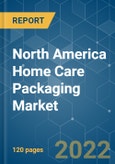The North American home care packaging market is expected to grow at a CAGR of 7.5% over the forecast period (2021 - 2026). Packaging trends, such as low cost, ease of use, and easy storage, have remained the major consumer trends in the review period. Small pack sizes, offering affordability to the entire consumer base, have emerged as more favorable alternatives among the brand owners to gain a competitive edge in the market.
Key Highlights
- North America is witnessing a growing need for reusable packaging solutions for home care products. For example, Blueland is a startup based in the USA that delivers detergent as tablets that need to be mixed with water in a reusable spray bottle to make the final product. Each tablet only weighs a couple of grams and can make more than half a liter of detergent, significantly reducing shipping and packaging costs.
- In the region, plastic and metal are the most preferred packaging materials for toiletries and home care products like detergent bottles and polish storage products. With this product category's growth, the use of materials is also expected to experience a growth trajectory.
- Currently, 73% of P&G Fabric Care packaging in North America (including Tide, Gain, and Downy) is recyclable. P&G has stated that they aim to accelerate their progress to make over 99% of NA Fabric Care packaging recyclable by 2023.
- The personal care and household goods provider, Unilever, whose beauty brands include Dove, Tresemme, and Toni & Guy, recently unveiled a new initiative, 'United for America,' to help people in the US manage the COVID-19 crisis. United For America has witnessed Unilever United States partner with the non-profit organization Feeding America to donate food, soap, personal hygiene, and home cleaning products worth more than USD 8 million to help those impacted by the coronavirus pandemic.
- The coronavirus pandemic caused a surge in toilet tissue sales, making toilet tissue products the leading home product category in the United States at about USD 10.4 billion.
Key Market Trends
Rising per capita income positively impacting the purchase power
- As per Organisation for Economic Co-operation and Development (OECD), the United States reported USD 14 trillion towards overall household spending. Moreover, allied personal income was recorded to have increased at USD 1,954.7 billion (10.0%) as of January 2020, according to the Bureau of Economic Analysis estimates.
- Similarly, the Disposable personal income (DPI) increased to amount to USD 1,963.2 billion (11.4%), along with personal consumption expenditures (PCE) increased by 2.4%.
- The PCE price index increased by 0.3% on a similar time frame, exclusive of food and energy estimates. This has been acting as an active driver to the increased purchasing power of the country’s consumers.
Plastic packaging is driving the market
- The wide usage of plastic through all major packaging types creates a market for plastic as a material. The flexibility, strength, and durability of the material make it ideal for packaging many liquids, cream, and powder products in the industry. Compared to other materials available, plastic remains highly flexible and can be molded into any shape. The significant drivers for plastic products are growing retail, increasing dual-income households, and rising demand for PET bottles.
- Apart from its favorable properties, innovations, such as tamper-evidence caps and closures, are gaining popularity, leading to a significant value add for the brand owners. This has driven the use of plastics across a variety of products.
- Furthermore, there is a gradual shift in customer preference toward adopting flexible plastic packaging over its rigid counterpart because of convenience and sustainability issues. Flexible plastic packaging materials are 80% lighter in weight than their equivalent rigid plastic materials and cheaper.
- However, environmental concerns associated with plastics have resulted in a slowdown in the market growth in the last decade. Nevertheless, with the advent of biodegradable plastics and recycling, plastics are expected to sustain their usage in the packaging world.
Competitive Landscape
The North American home care packaging market is competitive and consists of several major players. In terms of market share, few of the major players currently dominate the market. These major players with a prominent share in the market are expanding their customer base across foreign countries. These companies are leveraging on strategic collaborative initiatives to increase their market share and increase their profitability.
- September 2020 - Borealis and Menshen GmbH launched new packaging closures made of post-consumer recycled resin. The usage of Borcycle, an evolving recycling technology, transforms polyolefin-based waste streams into value-adding versatile solutions.
- June 2020 - Gualapack launched the first 100% mono-material recyclable pouches. Most multilayer multi-material laminates and pouches on the market have not been suitable for collection, sorting, or recycling. The company's Pouch5 offers a sustainable packaging solution for food, such as drinks and juices, beauty and personal care products, such as soap refills or face masks, and home care, like detergents.
Additional Benefits:
- The market estimate (ME) sheet in Excel format
- 3 months of analyst support
This product will be delivered within 2 business days.
Table of Contents
Methodology

LOADING...








